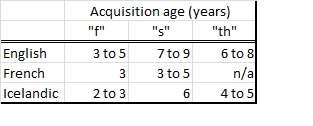I fell across this very intriguing paper in which the researchers used “bug in ear” devices to reinforce early childhood educators when they used language stimulation techniques with children in the preschool environment, specifically: following the child’s lead, offering the child choices, modeling correct language, waiting for responses, reinforcing desired responses, and expanding the child’s utterances. Three of these behaviors were selected individually for each educator because they did not or rarely used the strategy in practice. The researcher taught the educator to implement the strategy using modeling and role play activities and then deployed the “bug in ear” technology to reinforce use of the strategy while the educator was interacting with a specific child during play sessions in the natural preschool environment. Each strategy was introduced in turn using a multiple baseline single subject design, keeping child constant across each single subject experiment. The children were toddlers with autism spectrum and/or communication disorders. Child outcomes were described in terms of number of communicative attempts per minute whereas educator outcomes were described in terms of number of strategy uses per minute. The results were evaluated using an effect size metric designed for single subject experiments – the “improvement rate difference”. I have made a table of the results below for each of the four educator-child dyads, showing IRDs for the educator and the child during the intervention and maintenance phases, relative to baseline. Note that these verbal descriptions of effect size do not necessarily reflect the source of the effect. However, the raw data presentations of the multiple baseline experiments provide considerable confidence that the “bug in ear” technique was responsible for increases in strategy use by the educators. At the same time, any increases in communicative attempts by the children were not clearly associated with the intervention.

It can be seen from the table that the educators learned to use the strategies that were taught. The figures in the paper tell a more dramatic story with large and immediate increases in the use of each strategy as it was introduced to the educator by the researchers and reinforced using the “bug in ear” technology. Therefore this technology and the teaching strategies that were used proved to be a very effective option for improving clinical practice by practitioners. Presumably these teaching techniques could be used with our pre-professional students in our clinical programs. However, it was disappointing to see use of the strategies decline markedly after the researchers left the building (notice that IRDs are smaller during the maintenance phase (no bug in ear) than the intervention phase (bug in ear training phase). This is a known phenomenon – many researchers have remarked that extraordinary efforts must be made to maintain use of these strategies by educators. This study provides some clues as to why that might be. It can be seen that educators maintain their use of the strategies while they are receiving external reinforcement for doing so. During the active intervention stage the reinforcement comes from the researchers via the “bug in ear” technology. After the researchers stop providing this “unnatural” reinforcement, one might expect that the children themselves would provide ongoing reinforcements for the use of strategies designed to improve their communication skills. It can be seen here however that “natural” reinforcement is not forthcoming from the environment because the children are not substantially increasing their communicative attempts and most certainly not in direct response to the educators’ efforts.
This outcome reminds me of some old papers by Yoder and colleagues on the transactional nature of communicative exchanges between children with developmental delays and their parents and/or therapists. They were able to show that when prelinguistic milieu teaching changed the child’s behavior (i.e., increase in intentional communication), mothers changed their behavior in response (i.e., increased mapping of linguistic responses to the referent of the child’s communication). This transactional effect occurred even though the mothers were not involved in the direct (and rather directive) intervention that changed the child’s communication behaviors.
Francoise Brosseau-Lapré and I observed a similar effect in our recent study of speech therapy interventions to improve speech accuracy and phonological awareness. The study had multiple phases. Initially the children received individual speech therapy, observed by the parents. Then the parents were taught to implement a home program, in some cases a dialogic reading program in which the parents adopted a more active and directive teaching style when reading books with their child each evening. When this home program was preceded by an input oriented intervention, the dialogic reading intervention was a success, we believe because we first taught the children to listen carefully to speech input and to engage in reciprocal adult-child interactions. Alternatively, when the dialogic reading program was preceded by a traditional articulation therapy program, the parents reported that their children were annoyed by this new style of reading, preferring to be passive while the parent simply read the book. The children who experienced this combination of interventions did not experience as good outcomes as the children who experienced the former combination of interventions. We were unable to follow-up these families due to an unfortunate change in priorities by the funder. However, I strongly suspect the parents whose children were annoyed by dialogic reading would not be motivated to keep it up!
Currently when young children show delays in the development of communication skills it is common to work with the parents, entreating them to learn and increase the use of strategies that come naturally to middle class parents of children with normally developing speech and language. It is critical to understand the role of the child in eliciting and maintaining those behaviors however. Speech and language therapy cannot be expected to be effective without simultaneous attention to the child and the child’s environment.
References
